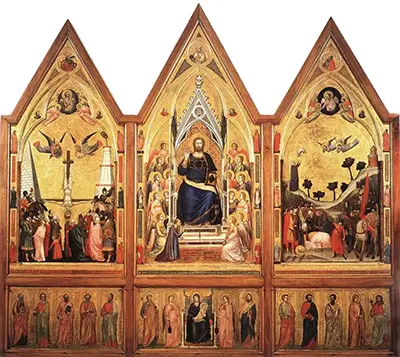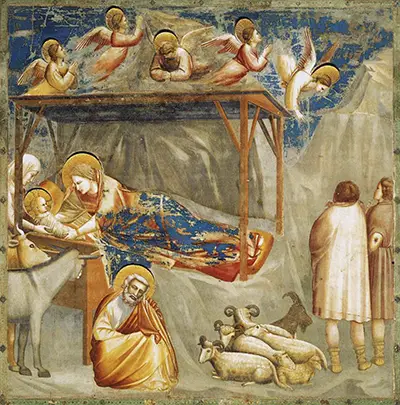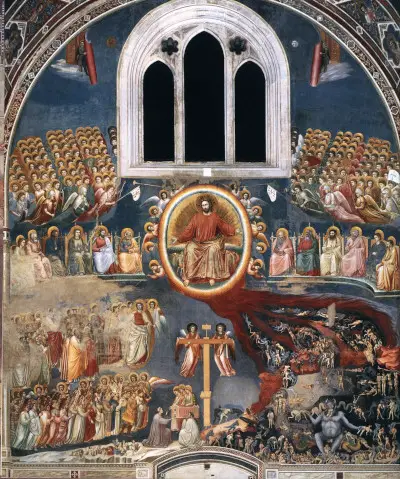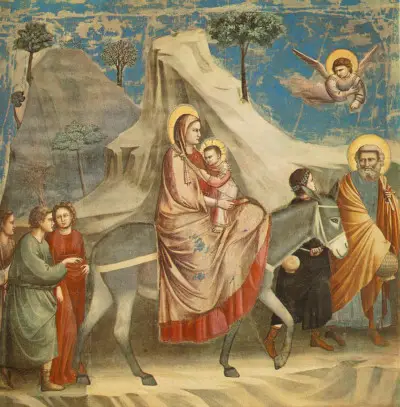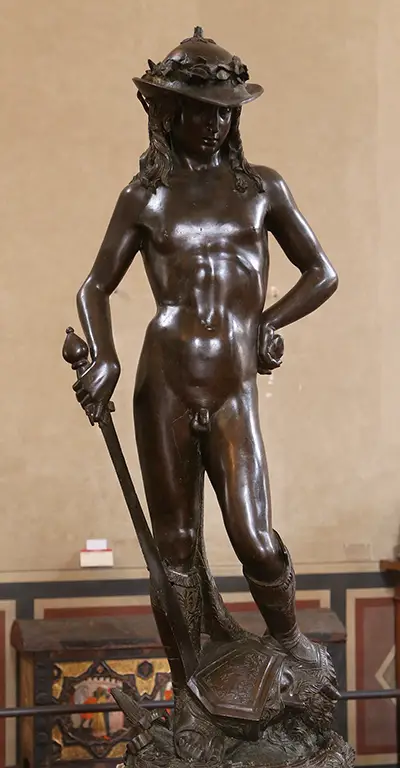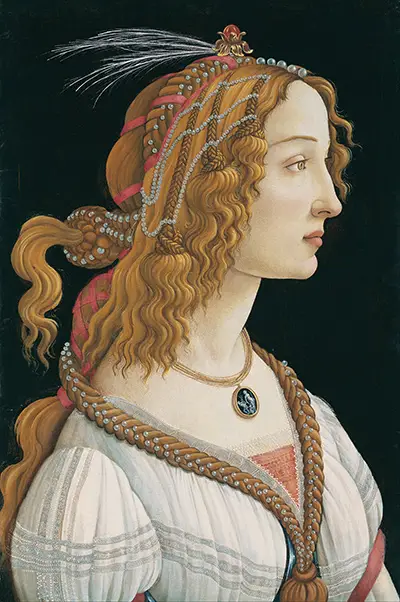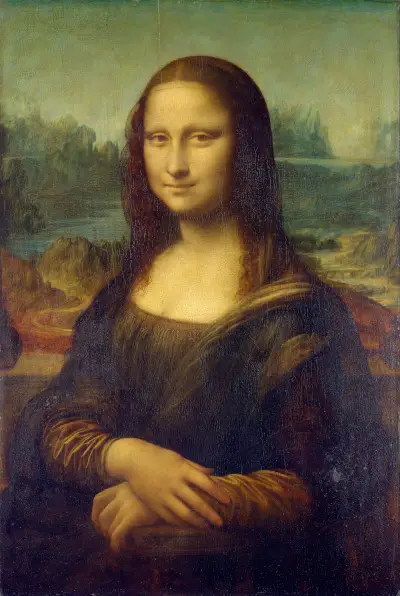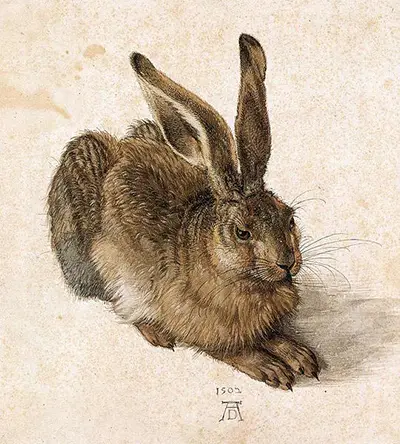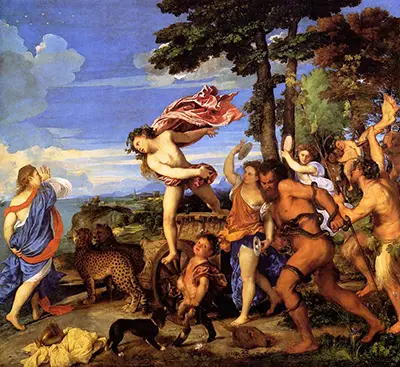Ognissanti Madonna is a huge painting by Giotto that can now be found at the Uffizi Gallery in Florence. The artist completed this fresco in around 1310.
The painting was originally designed to be placed in the high altar of the Ognissanti Franciscan church in Florence. It is dated at around 1310, with most evidence of its attribution to Giotto coming in an early biography of Lorenzo Ghiberti which arrived around a century later. Some of Giotto's installed paintings have been moved elsewhere from their original locations in order to ensure that as many people as possible can enjoy them as well as being confident that their condition is sufficiently protected.
Considering the fact that so many of Giotto's work has been damaged or completely lost, it is pleasing that this particular artwork remains well cared for in one of the most prestigious art musems in the world. It is the finer details of this painting that sets the artist out during this period. His use of multi-dimensional figures had not been seen before, where as his use of gold colouring was very much in line with previous works from others in the Italo-Byzantine movement. He would combine new and old, particularly during this time in his career when Giotto was continuing to develop as an artist.
Giotto makes a clear balance of importance in this composition, enlarging his central figures far beyond the supporting figures who line the edge of the canvas. The viewer is left in no doubt as to where their focus should lie. In fact, the baby himself is almost the same size as the adults who look on in admiration. The throne being sat upon by the Madonna is in a strictly gothic style as confirmed by the Cosmatesque features that decorate its frontage. This approach had been seen since the Middle Ages in several of the Papal States. Another interesting aspect of the way in which Giotto put this painting together is in the distinct lack of space that sits on the outer edges of the scene. This again focuses one on the key elements.
Table of Contents
- Where can Giotto's Ognissanti Madonna be found Today?
- What Techniques were used to Produce this Painting?
- What other Madonna's did Giotto Create?
- What Elements are Included within this Composition?
- Which Artists Influenced Giotto's Ognissanti Madonna?
- What is a Maestà?
- Why is this Painting called the Ognissanti Madonna?
- What other Paintings did Giotto Produce at Around the Same Time?
- Which related Artworks can also be Found at the Uffizi Gallery in Florence?
- Large Image of Giotto's Ognissanti Madonna
Where can Giotto's Ognissanti Madonna be found Today?
The Ognissanti Madonna can be found at the Galleria degli Uffizi in Florence, Italy. This highly significant artwork is normally on display alongside Cimabue's Santa Trinita Madonna and Duccio's Rucellai Madonna. They are within a hall titled "Giotto & the 13th Century" which lies on the second floor of this building and remains one of the biggest highlights to be found within the whole collection. These large fresco pieces have been given plenty of room within the museum and their locations within a major art gallery should help to ensure their preservation for the long term, as opposed to if they had remained within historical buildings in which the conditions are far more varied and unpredictable. Those lucky enough to visit the Uffizi will then find item sfrom the Sienese School and Florentine School from the 14th century in the adjoining rooms, giving the route something of a chronological order.
What Techniques were used to Produce this Painting?
Ognissanti Madonna (Madonna in Maestà) is believed to have taken several years to complete. It is a large piece, at over three metres in height. The gold leaf paint will likely take one's attention first, with Giotto favouring this look in many of his artworks. The background is entirely golden, and he would then use the same effect for small details within the main content, such as the halos. He would use some bright tones at the time of completing this piece, but some of the colours will inevitably have faded over time, even with the continual efforts to preserve the piece that have been made by its present owners at the Uffizi. Red was used on various items of clothing and this colour seems to have lasted best of all. The tempera work was added to a wooden panel, making the finished piece easier to relocate than if it had been directly applied to a wall's plaster surface which was another method used during the 13th and 14th century.
What other Madonna's did Giotto Create?
In terms of the artist's madonnas, The Bologna Polyptych features a relatively similar layout to the piece discussed here, whilst The Flight into Egypt features Mary with child on a famous journey. There was also Giotto's Madonna and Child, though the artist tended to depict Christ much more commonly than anyone else within his paintings. Whilst he was highly respected as an artist, and given many projects purely because of his reputation alone, there would still be interference over the topics of the paintings that he would produce, with churches and other institutions normally selecting the themes themselves. Themes from the life of Christ would dominate Italian art for several centuries and be used across a wide range of different mediums, including sculpture and architecture, as well as the frescoes discussed here. It was only really the arrival of the Baroque era that signalled a widening of content within western art, bringing in the a greater use of portraiture and leading on to landscape art soon after.
What Elements are Included within this Composition?
At around this time many Italian artists were producing depictions of the madonna within a wide format, with key figures placed in rows. Giotto chooses to use the more traditional format of a vertical, narrow composition where supporting figures are placed all around the centre piece. The madonna and child here are sat within a beautifully ornate construction, which protects them from outside forces. They sit on a raised platform which lifts them up above the saints and angels who surround them. Each figure possesses divinity as signified by their golden halos. Two angels, with wings brightly coloured hanging down from their back, are perched in the foreground, admirably looking up in awe. The saints are stood either side of the main focal point and offer the same expression, with chins lifted and a strong sign of respect on display. The background is left entirely blank, with gold leaf paint covered it entirely, with a slight gradiation in tone which lightens as we move further down the painting. The larger image of the painting below reveals further details, such as potted flowers and stunning gifts being offered to the madonna.
Which Artists Influenced Giotto's Ognissanti Madonna?
This artwork captures some of the stylistic touches that Giotto di Bondone would become particularly famous for. For example, notice how the madonna and child are heavily oversized in relation to the surrounding angels and saints. That is a method derived from Byzantine art, but other aspects of his work took in alternative influences. The gold leaf touches found within this painting were likely a direct result of his (likely) teachings under Cimabue, who would use similar methods himself. Some of the compositional choices are also very reminiscent of the Cimabue, with a clear symmetry found across the work. It can also be said that his figures are not delivered in a quite the same flat manner as normally found within medieval art and potentially this could show influence from sculptors of around the same time. He introduced more depth to the portraits in this piece, though there was still some way to go to reach the styles of the later phases of the Renaissance.
What is a Maestà?
The Maestà is a theme regularly used within tempera frescoes, with Giotto di Bondone continuing this trend in one of the more famous examples of it. The term translates as "majesty" and features the madonna and child sat down within a setting which promoted their significance. Typically, they would be placed centrally within the composition, and would often have angels and saints in large numbers across the rest of the work, though only the madonna and child were necessary for it to be termed as a Maestà. There have been different uses of the image across different cultures and periods, with western interpretations such as Giotto's most likely to have been influenced by earlier Byzantine mosaics. Many elements of that era would pass on into the Renaissance, due to the work of artists such as Giotto, Cimabue and Duccio. The elements of madonna and child are powerful themes which artists have wanted to tap into for their work, particularly as they were normally requested to cover only religious themes in any case for each commissioned piece.
Why is this Painting called the Ognissanti Madonna?
This tempera panel piece from around 1310 was originally planned to be installed at the Ognissanti Church in Florence, and so was named as the Ognissanti Madonna in order to differentiate it from the many other madonna paintings found within the career of Giotto and other artists from the 13th and 14th century. Art historians have regularly identified pieces in this way, either using the name of its original location or perhaps the identity of whoever commissioned the piece. The Rolin Madonna by Jan van Eyck would be one good example of this. Giotto's madonna would be moved several times and would eventually become located in Florence's prestigious Uffizi gallery, where it remains today. The term Ognissanti, from the Florentine church, translates into English as "All Saints" and is just one example of many depictions of the madonna by artist Giotto.
What other Paintings did Giotto Produce at Around the Same Time?
The artist is known to have worked upon the interior of the Palazzo della Ragione between the years of 1309-1312 which overlaps his time in Florence. He also produced the Death of the Virgin at around the same time as the Ognissanti Madonna, which itself is loosely dated at around 1310. Soon after, by around 1312 he would move onto Rome and work on various projects within the Navicella in St. Peter's, underlining how much the artist would move around Italy during this period in order to compelete various projects and commissioned pieces. He was very much in demand at the time, and did not find it necessary to spend much time promoting his reputation, such was the level of prominence that he had already achieved. He would then return to Florence between the years of 1313-1315 as new requests continued to be offered to him. Each Italian state was competing with each other during this era, and into the later parts of the Renaissance, and this would offer great opportunities to the more famous names in the artistic world.
Which related Artworks can also be Found at the Uffizi Gallery in Florence?
As mentioned elsewhere, Cimabue's Santa Trinita Madonna and Duccio's Rucellai Madonna can be found within the same room as Giotto's piece, with this route within the second floor of the Uffizi then leading into various Italian schools from across the 14th century. The Uffizi more generally is an excellent symbol of the strength of Florence during these artistic eras, even though much of its collection derives from elsewhere in the country. There is plenty other fine artworks to be found within this institution, with some of the other items to look out for here including the likes of Simone Martini's Annunciation with St. Margaret and St. Ansanus, Andrea del Verrocchio's The Baptism of Christ, Rogier van der Weyden's Lamentation of Christ and also Sandro Botticelli's Primavera, The Birth of Venus. The display continues into Baroque and features North European art, though Italian works form the majority of its focus.
Large Image of Giotto's Ognissanti Madonna

More Renaissance Artists




 Giotto.jpg)
 Giotto.jpg)
